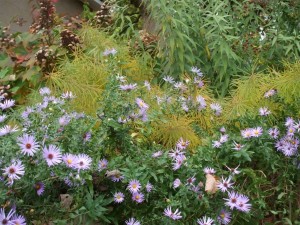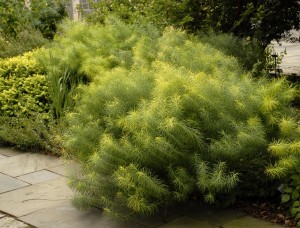
Amsonia hubrichtii blooms in late spring and early summer. (C) Steven Still/Perennial Plant Association.
A lovely plant with frothy green foliage, blue flowers and spectacular fall color has been name the 2011 Perennial Plant of the Year by the Perennial Plant Association, a trade group of educators, breeders. growers and retailers.
Arkansas bluestar (Amsonia hubrichtii) is a garden-worthy North America native perennial, first discovered in Arkansas by renowned plants man Leslie Hubricht, in 1942. It is related to the Eastern bluestar, Amsonia tabernaemontana, a larger plant with willow like foliage.
Arkansas bluestar gets about 3 feet tall and wide. Clusters of pale blue, star-shaped flowers form atop the stems, usually in May and June.
This perennial’s strongest attribute is not its flowers, though. It’s the foliage. The leaves are very fine and feathery, which adds an unusual and interesting texture to the landscape, complementing bolder leafed companions.

Arkansas bluestar (Amsonia hubrichtii) gets high marks for its fall show. Here, it provides the backdrop for the late-blooming 'Raydon's Favorite' aster with 'Sikes Dwarf' oakleaf hydrangea on the left. (C) Jo Ellen Meyers Sharp
But the real show is in fall, when Arkansas bluestar foliage turns brilliant gold, which lasts several weeks. The gold blends nicely with other plants with fall color, including native oakleaf hydrangeas (Hydrangea quercifolia), ornamental grasses or late blooming perennials, such as ‘Raydon’s Favorite’ aster (Symphyotrichum oblongifolium) and ‘Herbstfreude,’ marketed as Autumn Joy sedum (Hylotelephium spectabile).
Arkansas bluestar prefers a sunny location and average, moist, well-drained soil, but is quite tolerant of part shade and dry conditions. Soil that is too rich will cause the plant to flop. Plant as a specimen in the perennial garden or as a grouping of three or more for a mass showing. It also can be useful as a three-season hedge.

Arkansas bluestar (Amsonia hubrichtii) adds a frothy texture to the summer garden. Photo courtesy PerennialResource.com
Cut the plant back to the ground in late winter or early spring. Amsonia is related to the willow family and has a white sap that can stain clothing or irritate sensitive skin.
This plant should be readily available this spring at area garden centers and through mail order or online retailers.
I’m a big fan of this PPA POY too, Jo Ellen. Love that foliage.
And it lives for 25 years or longer. How many perennials will do that? It’s subtle and astounding.